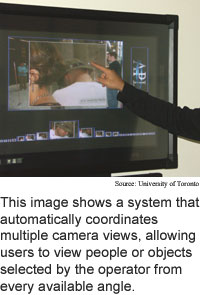
Multicamera surveillance automated
Imagine a bank of cameras trained at different
angles on many objects, such as people at an airport. It takes time for
an operator to look at the images in each camera, see if a particular
object of interest is in that image, then manually zoom in to take a closer
look.
Researchers from the University of Toronto have developed a system
that allows the user to indicate an object in one view and automatically
zoom to that object in all other views. The system sorts all the camera
views according to the quality of the view and zooms into all the images
that contain the object in about half a second in a system containing
as many as 200 cameras, according to the researchers.
The system can be used anywhere where multiple cameras are used
for surveillance, such as airports or casinos. It can also be used to
speed the process of parsing through a large number of still pictures
of a scene, such as archeological and crime scene pictures.
The researchers are working on adding real-time object tracking
to the system so it could to follow an object chosen by the user.
The system coordinates the multiple views using the three-dimensional
spatial location of the object of interest, which it finds using the visual
input plus sound localization information from an array of microphones.
The basic method is ready for practical applications now; real-time
object tracking will be ready for commercial use in about a year, according
to the researchers. The work appeared in the proceedings of the 2004 IEEE
International Conference on Systems, Man and Cybernetics held in October
in behavior, Netherlands.
For pure nanotubes add water
Solar cell doubles as battery
Conversational engagement tracked
Pure silicon laser debuts
Briefs:
Tight twist toughens nanotube fiber
Multicamera surveillance automated
Chemical keeps hydrogen on ice
Smart dust gets magnetic
Short nanotubes carry big currents
Demo advances quantum networking

Research Watch blog
View from the High Ground Q&A
How It Works
RSS Feeds:
News
Ad links:
Buy an ad link
Ad links: Clear History
Buy an ad link
|
TRN
Newswire and Headline Feeds for Web sites
|
© Copyright Technology Research News, LLC 2000-2010. All rights reserved.